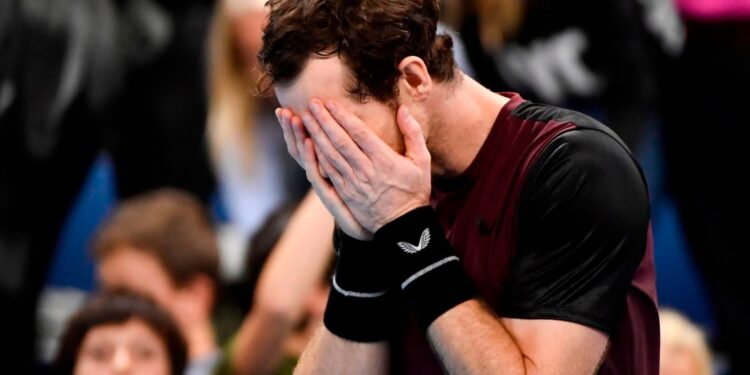Andy Murray, a three-time Grand Slam champion and one of the greatest players in British tennis history, has often been candid about his career and the state of tennis.

Since retiring from professional tennis, Murray has reflected on various aspects of the sport, including how the next generation of players is experiencing a vastly different landscape compared to when he, Roger Federer, Rafael Nadal, and Novak Djokovic dominated the scene.
In a recent interview, Murray explained why he believes the younger generation of tennis players has it “easy” compared to his era and what that means for the future of the sport.
### The Rise of the “Big Four” and Their Impact on Tennis
Murray was part of what has often been referred to as the “Big Four” of tennis—alongside Roger Federer, Rafael Nadal, and Novak Djokovic.
This group of players dominated the sport for nearly two decades, collectively winning the majority of Grand Slam titles and consistently occupying the top spots in the ATP rankings.
For much of Murray’s career, he faced the immense challenge of competing against these three legends, who were arguably playing some of the best tennis in history.
In explaining why the younger generation has it easier, Murray pointed to the sheer dominance of the “Big Four” and how it created an almost insurmountable barrier for anyone trying to break into the top ranks.
In his prime, breaking through meant not only having exceptional skill but also figuring out how to compete against players who were nearly unbeatable, both physically and mentally.
Each match against Federer, Nadal, or Djokovic was an immense challenge, requiring not just technical brilliance but extraordinary endurance and mental toughness.
Murray also highlighted the pressure that came with playing in an era dominated by such iconic figures.
He explained that each tournament, especially the Grand Slams, felt like an uphill battle because the expectation was that one of the “Big Four” would inevitably win.
Even reaching the final often meant having to go through at least two of these all-time greats, a daunting task that only a few managed to accomplish consistently.
### The Changing Landscape for the Next Generation
By contrast, Murray believes that the next generation of players—those born in the late 1990s and early 2000s—are entering a much more open field. While legends like Djokovic and Nadal are still active, they are not as invincible as they once were, and Federer has already retired.
This has created more opportunities for younger players to break through and win major titles. According to Murray, this shift in the competitive landscape is one of the reasons why the next generation has it easier.
Murray pointed out that players like Carlos Alcaraz, Jannik Sinner, and Holger Rune have emerged in a time when the dominance of the “Big Four” has waned. Without the same level of consistent competition from tennis’ historical giants, the pathway to success is more accessible.
These young stars are extremely talented, but they are not facing the same psychological challenge of having to outplay Federer or Nadal in nearly every major tournament. The mental block that players of Murray’s generation had to contend with is simply not as prevalent today.
He also noted the relatively fewer physical demands on the younger generation, as the sport’s scheduling has become more player-friendly. Advances in sports science, nutrition, and recovery techniques have given players better tools to maintain their health and longevity.
While injuries are still part of the game, Murray believes that today’s players have better resources and a more flexible calendar to manage their physical well-being compared to a decade ago.
### Financial and Sponsorship Opportunities
Another factor that Murray highlighted in his explanation is the financial landscape of tennis today.
When he was breaking into the professional ranks, the sport was already lucrative, but prize money and sponsorship deals have increased exponentially in recent years.
The younger generation of players can command large sums of money and sponsorship deals earlier in their careers, which takes some of the financial pressure off them as they focus on their performance.
Murray reflected on how, in his time, players had to grind through lower-tier tournaments to build their rankings and secure prize money. In contrast, today’s younger stars have access to higher earnings and can secure major sponsorship deals much earlier in their careers, allowing them to invest in better coaches, teams, and training facilities.
This financial security allows the next generation to focus more on their game without the added pressure of financial instability.
### The Role of Social Media and Global Exposure
Murray also mentioned the role of social media in shaping the careers of the next generation of tennis players. Today’s stars can build global brands and reach millions of fans instantly through platforms like Instagram, Twitter, and TikTok.
This level of exposure allows them to create their own narratives and engage with fans in ways that were not possible when Murray was rising through the ranks.
While social media can add pressure to players’ lives, it also provides an opportunity for younger athletes to build their public personas and gain endorsements.
Players like Coco Gauff and Carlos Alcaraz, for example, have used social media effectively to bolster their profiles, interact with fans, and attract sponsors.
Murray believes this is a major advantage that his generation did not have to the same extent, as they relied more on traditional media coverage to reach global audiences.
### Mental Health and the Next Generation
One of the most significant changes Murray pointed to is the increasing focus on mental health and well-being in modern tennis. In his era, there was little conversation about the mental pressures of professional sport, and players were often expected to tough it out in silence. Today, there is much more awareness around mental health, and players are encouraged to speak openly about the challenges they face.
Murray applauded this shift, acknowledging that the pressure of competing at the highest level can be overwhelming.
He noted that players like Naomi Osaka and Emma Raducanu have been vocal about their struggles, and the tennis community has responded by offering more support.
The younger generation is benefiting from a more holistic approach to player care, which includes mental health resources alongside physical training and recovery.
### The Future of Tennis
In explaining why he believes the next generation has it easier, Murray wasn’t suggesting that today’s players lack talent or determination.
Instead, he was pointing out the ways in which the sport has evolved to become more accessible, less dominated by a small group of players, and more supportive of the athletes’ overall well-being.
For Murray, the future of tennis is bright, and the next generation has a unique opportunity to shape the sport in their own image.
Without the same barriers that players of his era faced—both in terms of competition and external pressures—Murray believes the next wave of stars will continue to push tennis forward, creating new rivalries and moments of greatness.
### Conclusion
Andy Murray’s reflections on why tennis’ next generation has it easier offer a nuanced perspective on how the sport has changed over the past decade.
From the decline of the “Big Four” to the rise of social media and a greater focus on mental health, the landscape of tennis today is more open and supportive than it was during Murray’s prime.
While the next generation will face its own challenges, Murray believes that they are entering a sport that offers more opportunities to succeed, both on and off the court.










